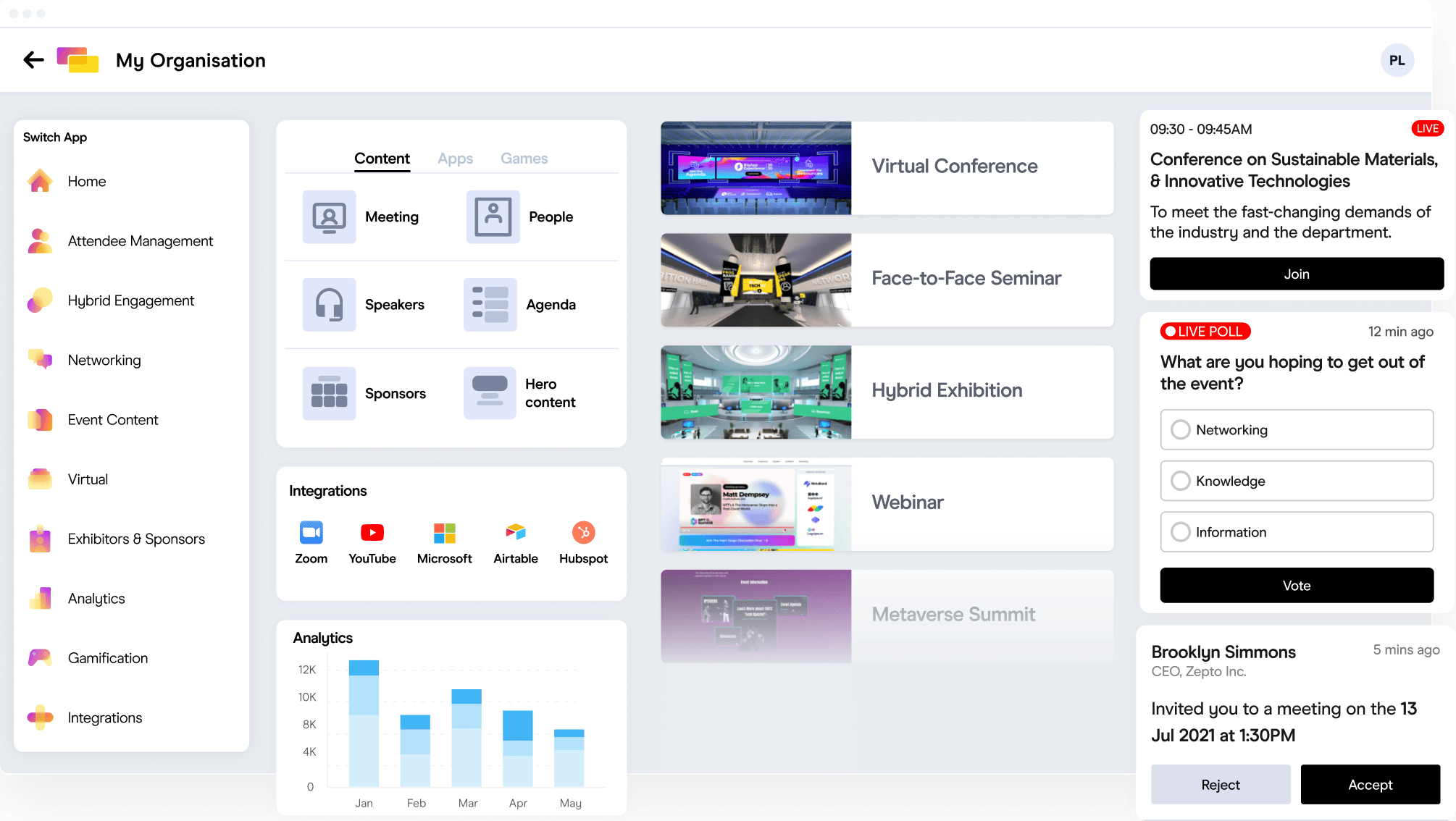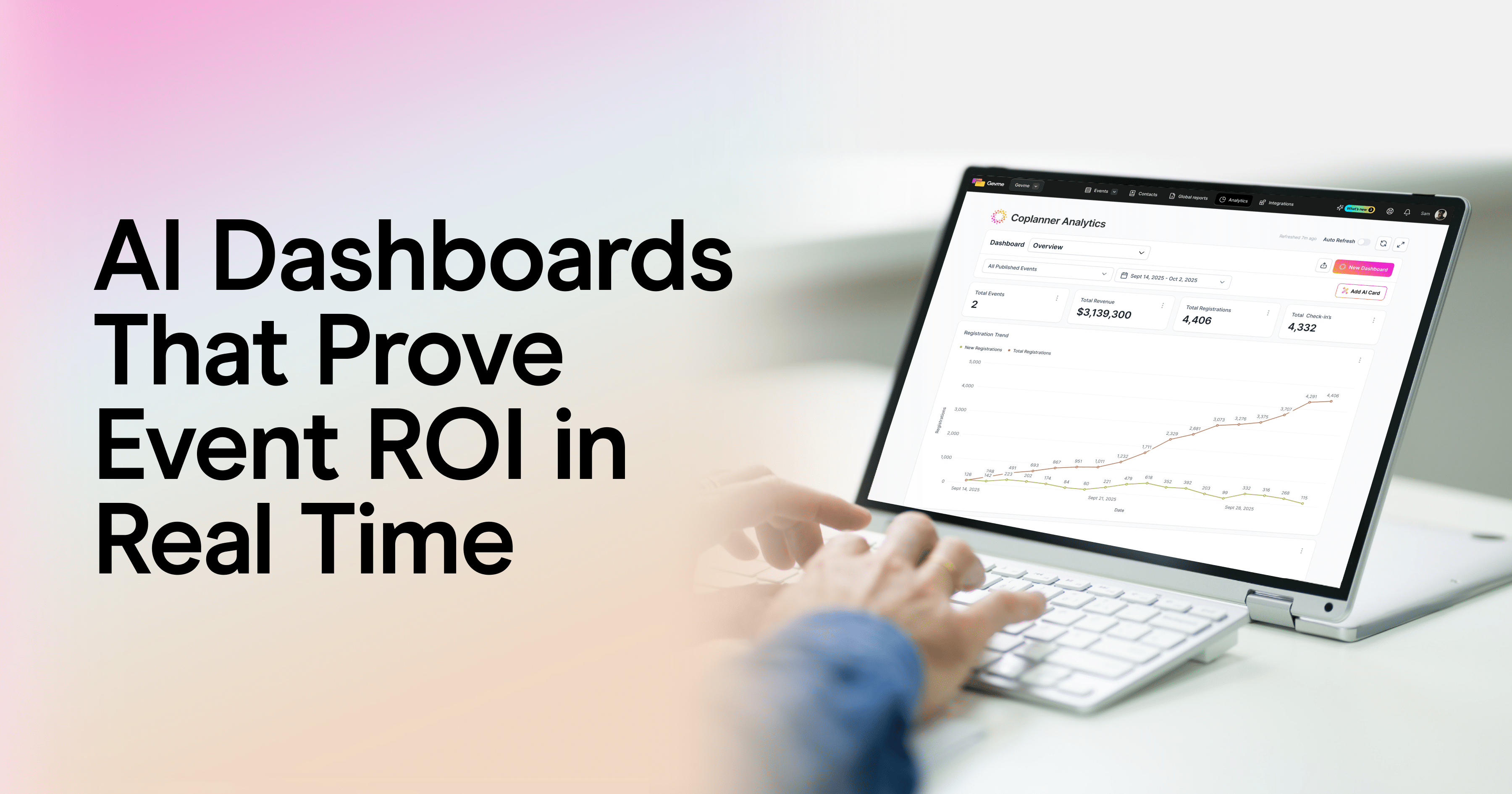Picture this: It’s 4pm on day two of the trade show. Your booth has been busy all day. Business cards are scattered across the table like confetti. Someone scribbled a phone number on the back of a flyer. Your sales rep swears they had “an amazing conversation with the CTO of that big company,” but can’t remember which company or what they discussed.
Sound familiar?
By the time you’re back in the office, half those leads are cold. The other half are illegible. And that “amazing conversation”? It’s become a vague memory and a missed opportunity. This is exactly why modern lead generation technology has become essential for serious exhibitors. Digital solutions eliminate these manual bottlenecks entirely.
This isn’t a people problem. It’s a process problem.
The best exhibitors at trade shows don’t just collect business cards and hope for the best. They treat lead generation like a system – one that captures, organizes, and qualifies prospects in real-time, right on the show floor.
What Effective Trade Show Lead Generation Really Means

Lead generation at trade shows means spotting the right people, asking the right questions, and capturing the details that actually matter when you follow up.
But here’s where most exhibitors get it wrong: they treat every interaction the same way.
Not every person who walks by your booth is a lead. Not every conversation is worth the same follow-up effort. And not every interaction should end with “here’s my card.”
The smartest booth teams understand that lead generation is about qualification, not quantity. They focus on three things:
Capture: Getting accurate contact details without friction
Context: Recording what matters – pain points, timeline, decision-making process
Classification: Rating lead quality so follow-up is prioritized correctly
Everything else is just busy work.
Of course, even the best systematic approach can be undermined by inefficient tools. That’s why successful exhibitors combine strong processes with modern lead generation technology that supports their methodology rather than complicates it.
Building Your Lead Qualification Framework
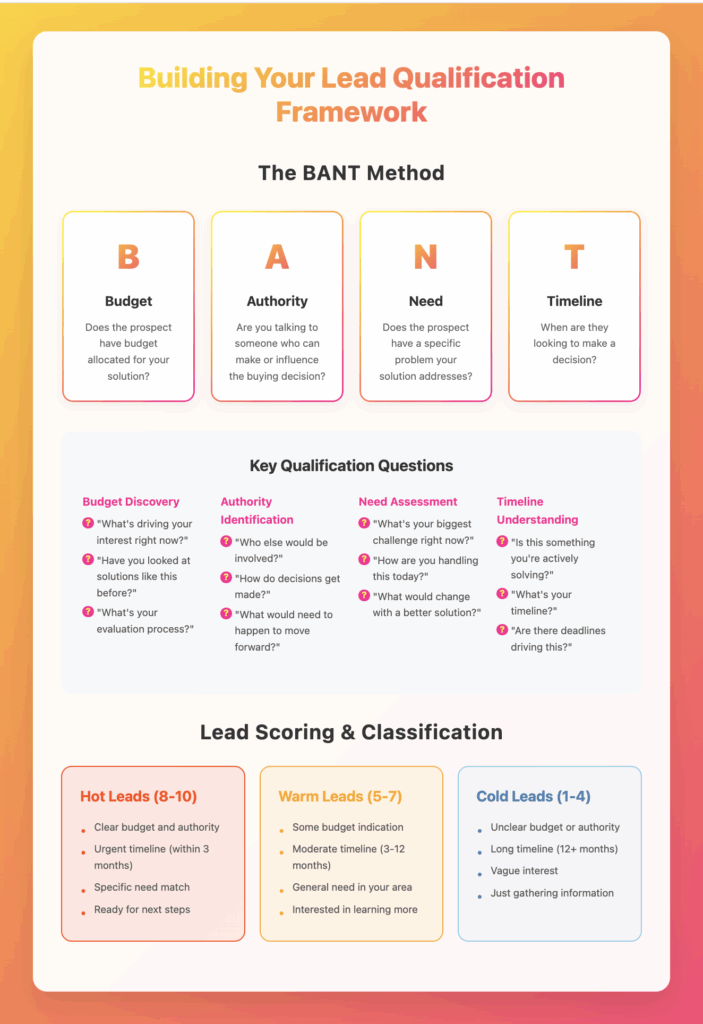
Before your team sets foot on the show floor, you need clear criteria for what constitutes a qualified lead. Without this framework, your booth staff will waste time on unqualified prospects and miss genuine opportunities.
The BANT Qualification Method
The most effective lead qualification framework focuses on four key areas:
Budget: Does the prospect have budget allocated for your type of solution? When prospects say “we don’t have budget,” dig deeper. Do they mean no budget this year, or no budget ever? Is budget something they could secure if they found the right solution?
Authority: Are you talking to someone who can make or influence the buying decision? This doesn’t mean you only talk to C-level executives. Often, the technical evaluator or department manager has significant influence on vendor selection.
Need: Does the prospect have a specific problem your solution addresses? Generic interest isn’t enough. Look for concrete pain points, current workarounds they’re using, or initiatives they’re planning that your solution supports.
Timeline: When are they looking to make a decision? “Someday” isn’t a timeline. “We’re evaluating solutions to implement before Q4” is actionable information.
Creating Your Qualification Questions
Your booth team needs specific questions that uncover BANT information without sounding like an interrogation. Here are conversation starters that work:
For Budget Discovery:
- “What’s driving your interest in [solution type] right now?”
- “Have you looked at solutions like this before?”
- “What’s your process for evaluating new tools like ours?”
For Authority Identification:
- “Who else would be involved in evaluating something like this?”
- “How do decisions like this typically get made at your company?”
- “What would need to happen for you to move forward with a solution?”
For Need Assessment:
- “What’s your biggest challenge with [relevant area] right now?”
- “How are you handling [specific process] today?”
- “What would change if you had a better way to [do their job]?”
For Timeline Understanding:
- “Is this something you’re actively looking to solve?”
- “What’s your timeline for getting something like this in place?”
- “Are there any deadlines or events driving your timeline?”
Lead Scoring and Classification
Not all qualified leads are created equal. Develop a simple scoring system that your booth staff can apply consistently:
Hot Leads (Score: 8-10)
- Clear budget and authority
- Urgent timeline (within 3 months)
- Specific need that matches your solution
- Ready to discuss next steps
Warm Leads (Score: 5-7)
- Some budget indication
- Moderate timeline (3-12 months)
- General need in your area
- Interested in learning more
Cold Leads (Score: 1-4)
- Unclear budget or authority
- Long timeline (12+ months)
- Vague interest
- Just gathering information
This scoring helps prioritize follow-up efforts and ensures hot leads get immediate attention.
Pre-Event Planning and Preparation

Successful lead generation starts long before the trade show doors open. The preparation phase determines whether your team captures quality leads or just collects business cards.
Defining Your Ideal Customer Profile
Before your team talks to anyone, they need to know who they should be talking to. Create detailed profiles of your ideal prospects:
Company Characteristics:
- Industry verticals
- Company size (employees, revenue)
- Geographic location
- Technology stack
- Growth stage
Buyer Personas:
- Job titles and departments
- Primary responsibilities
- Pain points and challenges
- Decision-making authority
- Preferred communication styles
Qualifying Scenarios:
- Specific use cases your solution addresses
- Budget ranges that make sense
- Timeline indicators that suggest urgency
- Competitive situations you can win
Share these profiles with your entire booth team so everyone knows who to prioritize.
Setting Lead Generation Goals
Vague goals like “get more leads” don’t drive behavior. Set specific, measurable targets:
Quantity Goals:
- Total leads per day/event
- Leads per booth staff member
- Qualified leads vs. total contacts
Quality Goals:
- Percentage of hot/warm/cold leads
- Average lead score
- Leads matching ideal customer profile
Outcome Goals:
- Follow-up meeting bookings
- Demo requests generated
- Pipeline value created
These goals help booth staff prioritize quality over quantity and give you benchmarks for measuring success.
Booth Layout for Lead Generation
Your booth design should facilitate lead generation, not hinder it. Consider these layout principles:
Open and Accessible: Avoid barriers that make prospects hesitant to approach. High counters, cluttered displays, and closed-off areas reduce foot traffic.
Conversation Zones: Create dedicated spaces for longer conversations with qualified prospects. These should be slightly removed from high-traffic areas but still visible.
Lead Capture Stations: Have designated areas where booth staff can add notes and ratings immediately after conversations. This shouldn’t be done in front of prospects.
Literature and Leave-Behinds: Position materials strategically so they support conversations rather than replace them. Prospects should talk to your team to get the good stuff.
Training Your Booth Team for Success
Even the best lead generation process fails without proper team training. Your booth staff are your front-line lead generators – invest in their success.
Pre-Show Training Essentials
Product Knowledge: Every team member should understand your solution’s key benefits, competitive advantages, and common use cases. They don’t need to be technical experts, but they should answer basic questions confidently.
Qualification Training: Role-play different prospect scenarios so staff practice identifying qualified leads. Use real examples from past events to make training relevant.
Conversation Flow: Teach a consistent approach to booth conversations:
- Welcome and open-ended question
- Listen for qualification indicators
- Ask follow-up questions based on their responses
- Determine next steps
- Capture information and rating
Objection Handling: Prepare responses to common objections like “we’re not ready,” “we’re already looking at competitors,” or “send me information.” Practice turning objections into qualification opportunities.
Booth Behavior Guidelines
Engagement Rules:
- Stand up and be approachable
- Make eye contact and smile
- Avoid phone conversations during show hours
- Don’t cluster together in groups
- Engage prospects within 30 seconds of approach
Conversation Management:
- Ask open-ended questions
- Listen more than you talk
- Focus on their challenges, not your features
- Keep initial conversations to 10-15 minutes
- Know when to end unqualified conversations politely
Lead Capture Protocol:
- Capture information immediately after conversations
- Include specific notes about their situation
- Rate leads consistently using your scoring system
- Identify next steps before they leave
- Follow up on promises made during conversation
Handling Different Prospect Types
Train your team to recognize and adapt to different prospect personalities:
The Researcher: Wants detailed information and documentation. Provide comprehensive resources but also schedule follow-up for deeper discussion.
The Skeptic: Questions everything and compares to competitors. Focus on specific differentiators and offer proof points like case studies or references.
The Decider: Direct and focused on outcomes. Skip feature details and focus on business impact and ROI. Be prepared to discuss next steps immediately.
The Influencer: May not make final decisions but influences the process. Understand their role and provide materials they can share with decision-makers.
Conversation Approaches and Tactics
Great booth conversations don’t happen by accident. They follow proven patterns that uncover prospect needs and build genuine interest.
The Opening: Drawing People In
Avoid Generic Questions:
- “How’s the show going?” (Everyone asks this)
- “What brings you by?” (Too vague)
- “Are you interested in [product]?” (Yes/no question)
Use Engaging Openers:
- “What’s the biggest challenge you’re facing with [relevant area]?”
- “How are you handling [specific process] at your company right now?”
- “What would make this show a success for you?”
Physical Positioning:
- Stand at the edge of your booth space
- Make yourself available without being aggressive
- Use open body language
- Let prospects browse briefly before engaging
The Qualification: Understanding Their Situation
Once you’ve opened the conversation, guide it toward qualification without making it feel like an interview:
Discovery Questions:
- “Tell me about your role at [company]”
- “What’s working well with your current approach to [area]?”
- “What’s not working as well as you’d like?”
- “Who else is involved in decisions like this?”
- “What’s driving your interest in looking at new solutions?”
Building on Their Responses:
- “That’s interesting, tell me more about that”
- “How is that impacting your team?”
- “What would it mean if you could solve that?”
- “Have you looked at other ways to address this?”
Qualification Indicators to Listen For:
- Specific problems or pain points
- Budget discussions or procurement processes
- Timeline pressure or deadlines
- Mentions of current tools or vendors
- Team size or volume metrics
The Value Connection: Making It Relevant
Once you understand their situation, connect it to your solution’s value:
Focus on Outcomes, Not Features:
- Instead of: “Our software has advanced analytics”
- Say: “So you could get the visibility you need to make more informed decisions”
Use Their Language:
- Mirror the terms and phrases they use
- Reference their specific situation
- Connect to their stated priorities
Share Relevant Examples:
- “We work with other [industry] companies who had similar challenges”
- “One customer saved 40% of their time by automating [process]”
- “Companies like yours typically see ROI within [timeframe]”
The Next Step: Moving Beyond the Booth
Every qualified conversation should end with a clear next step:
For Hot Leads:
- Schedule specific follow-up meeting
- Book onsite demo during the event
- Arrange introduction to technical specialist
- Set up pilot or trial discussion
For Warm Leads:
- Send relevant case studies or resources
- Invite to upcoming webinar or event
- Schedule exploratory call in coming weeks
- Connect on LinkedIn with personalized message
For Cold Leads:
- Add to appropriate nurture campaign
- Send educational content series
- Invite to lower-commitment engagement
- Set follow-up reminder for future
Post-Event Conversion Strategies
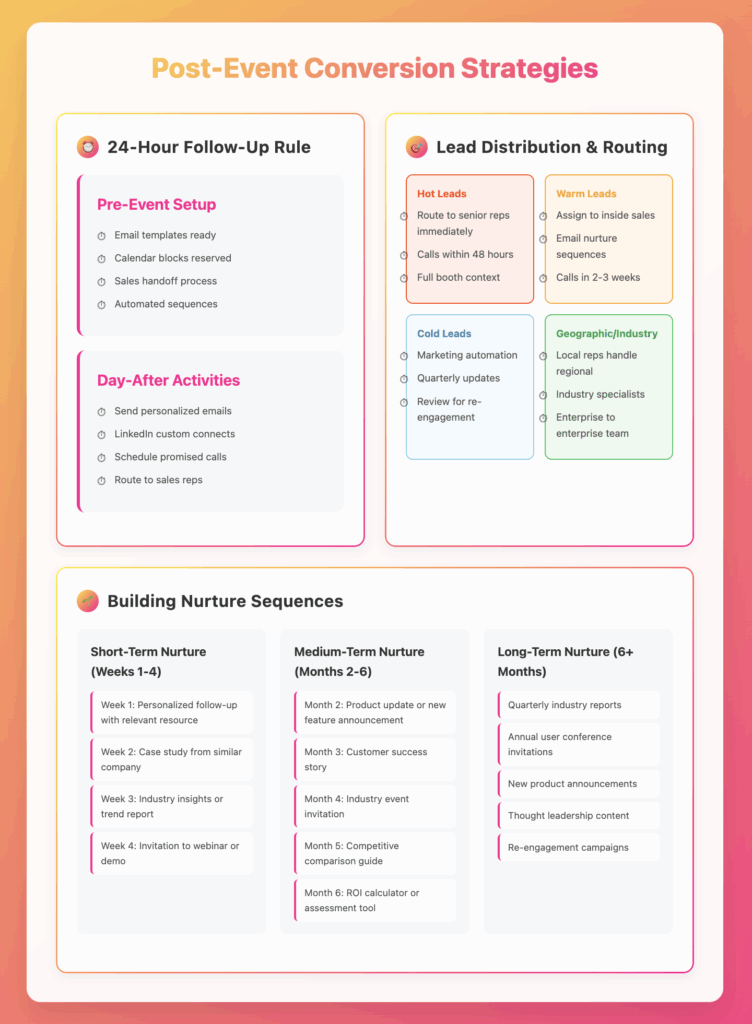
The real work begins after the trade show ends. Most exhibitors fail during this phase by treating leads like a to-do list instead of sales opportunities.
The 24-Hour Follow-Up Rule
Trade show leads have a short shelf life. The longer you wait to follow up, the less likely you are to convert them into sales conversations.
The best performing booth teams follow up within 24 hours of the event ending. Not 24 hours after they get back to the office. 24 hours after the last day of the show.
This timeline is only achievable with proper preparation:
Pre-Event Setup:
- Email templates for different lead types
- Calendar blocks for follow-up activities
- Clear handoff process to sales team
- Automated sequences ready to deploy
Day-After Activities:
- Send personalized follow-up emails
- Connect on LinkedIn with custom messages
- Schedule promised meetings or calls
- Route leads to appropriate sales reps
The most efficient teams also leverage automated lead nurturing and CRM integration to handle the technical execution while they focus on the personal touches that matter
Personalized Follow-Up at Scale
Generic “thanks for visiting our booth” emails don’t work. Prospects can tell when you’re mass-mailing, and they respond accordingly.
Effective follow-up references specific conversation points, addresses the pain points they mentioned, and provides relevant next steps based on their expressed interests.
Hot Lead Follow-Up Template:
Subject: [Specific topic we discussed] - Next Steps
Hi [Name],
Great meeting you at [Event] yesterday. I've been thinking about your challenge with [specific problem] and how it's impacting [their situation].
Based on our conversation, I think [specific solution aspect] could really help with [their goal]. I'd love to show you how [similar company] addressed the same issue.
Are you available for a 30-minute call this week? I have openings on [specific times].
Best regards,
[Your name]
P.S. Here's that [resource/case study] I mentioned: [link]
Warm Lead Follow-Up Template:
Subject: [Event] follow-up - [Relevant resource]
Hi [Name],
Thanks for stopping by our booth at [Event]. I enjoyed our conversation about [topic discussed].
I thought you might find this [resource type] useful: [resource title]. It addresses [specific challenge they mentioned] that companies in [their industry] often face.
No immediate action needed – just wanted to share something relevant. Feel free to reach out if you'd like to continue the conversation.
Best,
[Your name]
Lead Distribution and Routing
Different types of leads require different follow-up approaches and team members:
Hot Leads:
- Route to senior sales reps immediately
- Schedule phone calls within 48 hours
- Provide full context from booth conversations
- Set up technical demos if appropriate
Warm Leads:
- Assign to inside sales for nurturing
- Send educational email sequences
- Invite to webinars or virtual events
- Schedule follow-up calls in 2-3 weeks
Cold Leads:
- Add to marketing automation campaigns
- Send quarterly industry updates
- Invite to low-commitment content
- Review quarterly for re-engagement
Geographic/Industry Routing:
- Local sales reps handle regional prospects
- Industry specialists manage vertical leads
- Technical prospects go to solution engineers
- Enterprise leads route to enterprise team
Building Nurture Sequences
Not every trade show lead is ready to buy immediately. Some prospects are early in their research process. Others are evaluating multiple vendors over months or quarters.
Short-Term Nurture (Weeks 1-4):
- Week 1: Personalized follow-up with relevant resource
- Week 2: Case study from similar company
- Week 3: Industry insights or trend report
- Week 4: Invitation to webinar or demo
Medium-Term Nurture (Months 2-6):
- Month 2: Product update or new feature announcement
- Month 3: Customer success story
- Month 4: Industry event invitation
- Month 5: Competitive comparison guide
- Month 6: ROI calculator or assessment tool
Long-Term Nurture (6+ Months):
- Quarterly industry reports
- Annual user conference invitations
- New product announcements
- Thought leadership content
- Re-engagement campaigns
Measuring Lead Generation Success
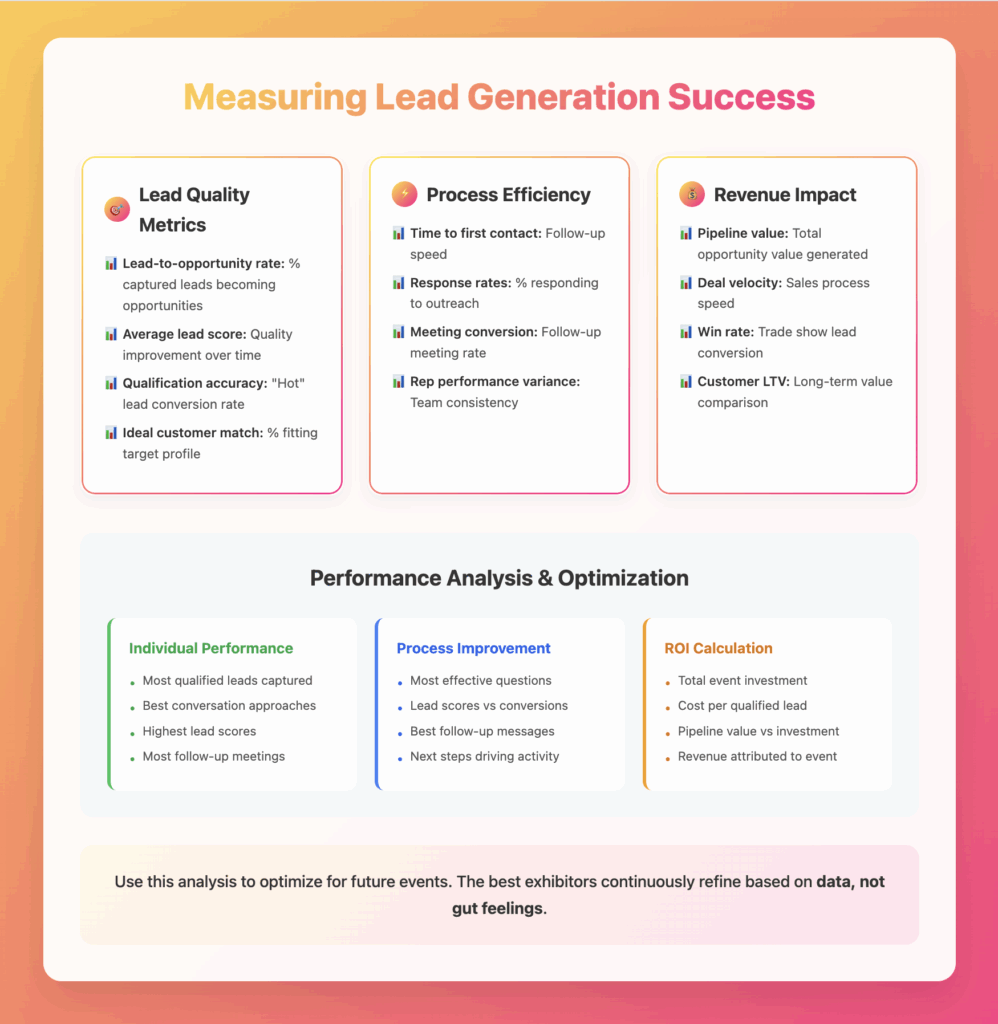
Most exhibitors measure trade show success by booth traffic or total leads captured. These metrics feel good but don’t correlate with revenue.
Metrics That Truly Matter
Lead Quality Metrics:
- Lead-to-opportunity conversion rate: What percentage of captured leads become sales opportunities?
- Average lead score: Are you capturing higher-quality prospects over time?
- Qualification accuracy: How often do leads rated as “hot” actually convert?
- Ideal customer match: What percentage of leads fit your target profile?
Process Efficiency Metrics:
- Time to first contact: How quickly are leads being followed up?
- Response rates: What percentage of leads respond to initial outreach?
- Meeting conversion: How many leads agree to follow-up meetings?
- Rep performance variance: Are some team members consistently capturing better leads?
Revenue Impact Metrics:
- Pipeline value generated: Total opportunity value from trade show leads
- Deal velocity: How fast do trade show leads move through your sales process?
- Win rate: Do trade show leads convert to customers at higher rates?
- Customer lifetime value: Are trade show customers more valuable long-term?
Performance Analysis and Optimization
Individual Performance Review:
- Which booth staff captured the most qualified leads?
- What conversation approaches generated the best responses?
- Which team members had the highest lead scores?
- Who generated the most follow-up meetings?
Process Improvement Analysis:
- Which qualification questions were most effective?
- What lead scores correlated with actual conversions?
- Which follow-up messages got the best response rates?
- What next steps led to the most sales activity?
ROI Calculation:
- Total event investment (booth, travel, staff time)
- Lead generation costs per qualified lead
- Pipeline value generated vs. investment
- Actual revenue attributed to the event
Use this analysis to optimize your approach for future events. The best exhibitors continuously refine their lead generation processes based on data, not gut feelings.
Speaking of data, integrated lead generation platforms can provide the detailed analytics needed to make these optimizations systematic rather than guesswork.
Building Your Lead Generation System
Successful trade show lead gen isn’t a one-off stunt. It’s a system you tweak, test, and scale.
Documenting Your Process
Create written procedures for:
- Pre-event planning and goal setting
- Lead qualification criteria and scoring
- Booth conversation guidelines
- Follow-up timing and templates
- Lead routing and handoff procedures
- Performance measurement and analysis
Training and Development
- Regular role-playing sessions for booth staff
- Quarterly review of lead generation performance
- Sharing best practices across the team
- Ongoing product and industry training
- Customer feedback integration
Continuous Improvement
- Post-event debriefs with the entire team
- Analysis of what worked and what didn’t
- Updates to qualification criteria based on results
- Refinement of conversation approaches
- Optimization of follow-up sequences
Stop Leaving Revenue on the Show Floor
Every missed conversation is potential revenue walking away. Every unqualified lead that gets the same follow-up as a hot prospect is a resource allocation mistake. Every generic follow-up email is a missed opportunity to build a meaningful business relationship.
The companies that master trade show lead generation don’t just have better event ROI. They build predictable revenue streams from live events and create sustainable competitive advantages.
Your next trade show is an opportunity to implement this systematic approach. Start with clear qualification criteria, train your team properly, and execute follow-up that turns conversations into revenue.
The exhibitors who treat lead generation as a strategic process will dominate their markets. The ones who wing it and hope for the best will keep wondering why their trade show investments don’t pay off.
Which approach will you choose?
FAQ’s
A qualified lead meets your BANT criteria: Budget (has funds allocated or ability to secure them), Authority (can influence or make buying decisions), Need (has specific problems your solution addresses), and Timeline (has urgency to make a decision within reasonable timeframe).
Quality matters more than quantity. A good benchmark is 8-12 meaningful conversations per day per staff member, with 30-40% being qualified leads. Focus on lead scores and conversion rates rather than total volume.
Use engaging, open-ended questions that focus on their challenges rather than your products. Start with questions like “What’s your biggest challenge with [relevant area]?” rather than generic openers like “How’s the show going?”
Within 24 hours of the event ending for hot leads, within 48-72 hours for warm leads. Speed matters because prospects are often evaluating multiple vendors and first responders get advantage in scheduling meetings.
Treating all leads the same way. Without proper qualification and scoring, companies waste resources following up with unqualified prospects while hot leads get delayed attention. Build a systematic approach that prioritizes quality over quantity.

